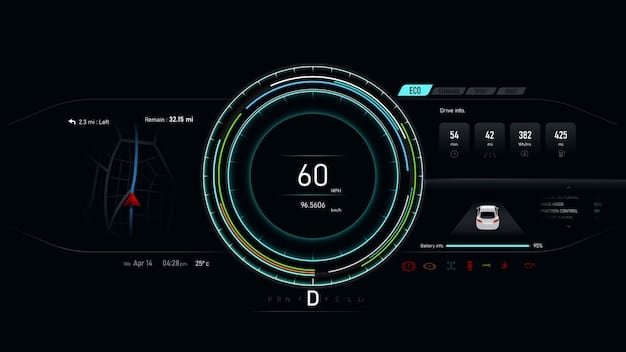Electric Vehicle OTA Updates: What Manufacturers Offer in the Next 6 Months

Over-the-air (OTA) software updates are becoming increasingly common in electric vehicles (EVs), allowing manufacturers to remotely improve vehicle performance, add new features, and fix bugs. Several EV manufacturers are planning or already offering significant OTA updates in the next six months, enhancing the user experience and vehicle functionality without requiring a visit to a service center.
The automotive industry is rapidly evolving, and electric vehicles (EVs) are at the forefront of this transformation. One of the most significant advancements is the implementation of over-the-air (OTA) software updates. In this article, we will explore what electric vehicle manufacturers are offering over-the-air software updates in the next 6 months, discussing the benefits, the manufacturers leading the charge, and what you can expect for your EV.
The Rise of Over-the-Air Updates in EVs
Over-the-air (OTA) updates have revolutionized how software is managed and updated in various devices, from smartphones to smart home appliances. In the automotive sector, OTA updates offer a convenient way for manufacturers to enhance vehicle performance, introduce new features, and rectify bugs without the traditional trip to a service center. This capability is particularly crucial in the fast-paced world of electric vehicles, where continuous improvements and software enhancements are expected.
The benefits of OTA updates are extensive. They improve vehicle performance by optimizing energy consumption, enhancing driving dynamics, and refining battery management systems. New features can be added, such as advanced driver-assistance systems (ADAS), improved navigation, and enhanced infotainment options. Additionally, OTA updates can quickly address software bugs and security vulnerabilities, ensuring that the vehicle operates smoothly and safely.
Why OTA Updates are Essential for Modern EVs
OTA updates are not just a convenience; they are essential for modern EVs. As EVs become increasingly reliant on software for core functions, the ability to deliver updates remotely ensures that vehicles can evolve and improve over time. This capability helps maintain the vehicle’s value, extend its lifespan, and enhance the overall ownership experience.
Furthermore, OTA updates allow manufacturers to gather data and feedback from vehicles in the field, enabling them to identify and address potential issues more efficiently. This iterative process leads to continuous improvement, ensuring that EVs stay current and competitive in a rapidly changing market.

How OTA Updates Differ from Traditional Vehicle Updates
Traditional vehicle updates involve physical visits to a service center, which can be time-consuming and inconvenient. These updates often address specific issues or involve the installation of new hardware components. OTA updates, on the other hand, are delivered remotely via wireless connectivity, making the update process seamless and unobtrusive for the vehicle owner.
- Convenience: OTA updates can be performed at the owner’s convenience, eliminating the need for scheduling appointments and taking time off work.
- Speed: OTA updates are typically much faster than traditional updates, often completed in a matter of minutes or hours.
- Cost-Effective: OTA updates can reduce the cost of maintenance and repairs by addressing issues remotely, minimizing the need for physical service visits.
- Continuous Improvement: OTA updates enable manufacturers to continuously improve vehicle performance, features, and security, ensuring that EVs stay current and competitive.
In conclusion, OTA updates represent a significant advancement in vehicle maintenance and management, offering numerous benefits for both manufacturers and vehicle owners. As EVs continue to evolve, OTA updates will play an increasingly critical role in ensuring that these vehicles remain at the forefront of innovation and performance.
Manufacturers Leading the OTA Revolution
Several electric vehicle (EV) manufacturers are at the forefront of the over-the-air (OTA) update revolution, continuously pushing the boundaries of what’s possible with remote software enhancements. These manufacturers are committed to delivering innovative features, performance improvements, and bug fixes directly to their vehicles, enhancing the overall ownership experience.
Tesla has been a pioneer in OTA updates, offering a wide range of enhancements, from performance boosts to advanced driver-assistance features. Other manufacturers, such as Rivian and Lucid Motors, are also making significant strides in OTA technology, focusing on delivering seamless and valuable updates to their customers.
Tesla: The Pioneer of OTA Updates
Tesla has long been recognized as a leader in OTA updates, setting the standard for other EV manufacturers to follow. Tesla’s OTA updates have included performance improvements, such as increased horsepower and acceleration, as well as new features, such as advanced driver-assistance systems (ADAS) and enhanced infotainment options. These updates are delivered regularly, ensuring that Tesla vehicles stay current and competitive.
Tesla’s commitment to OTA updates extends beyond just software enhancements. The company has also used OTA updates to address safety concerns and recalls, quickly deploying fixes to vehicles in the field without requiring owners to visit a service center. This proactive approach has helped Tesla maintain its reputation for innovation and customer satisfaction.
Rivian: Delivering Adventure-Ready Updates
Rivian is another EV manufacturer making significant strides in OTA updates. Rivian’s updates focus on enhancing the adventure-ready capabilities of its vehicles, such as the R1T pickup truck and R1S SUV. These updates have included improvements to off-road performance, enhanced battery management, and new features for camping and outdoor activities.

Rivian’s OTA updates also address customer feedback and feature requests, demonstrating the company’s commitment to delivering a personalized and evolving ownership experience. By continuously improving its vehicles through OTA updates, Rivian is positioning itself as a leader in the electric adventure vehicle market.
Lucid Motors: Emphasizing Luxury and Performance
Lucid Motors is focused on delivering OTA updates that emphasize luxury and performance. Lucid’s updates have included improvements to vehicle handling, enhanced battery efficiency, and new features for the Lucid Air sedan’s advanced infotainment system. These updates are designed to provide a seamless and premium driving experience for Lucid owners.
- Performance Enhancements: OTA updates can improve vehicle handling, acceleration, and braking performance, enhancing the overall driving experience.
- Battery Efficiency: OTA updates can optimize battery management systems, improving energy consumption and extending the vehicle’s range.
- Infotainment Updates: OTA updates can add new features to the vehicle’s infotainment system, such as enhanced navigation, streaming services, and smartphone integration.
- Bug Fixes and Security Updates: OTA updates can quickly address software bugs and security vulnerabilities, ensuring that the vehicle operates smoothly and safely.
In conclusion, Tesla, Rivian, and Lucid Motors are leading the OTA revolution in the EV industry, demonstrating the power of remote software enhancements to improve vehicle performance, add new features, and enhance the overall ownership experience. As more EV manufacturers adopt OTA technology, we can expect to see even greater innovation and continuous improvement in the years to come.
What to Expect in the Next 6 Months
The next six months promise to be an exciting period for electric vehicle (EV) owners, with several manufacturers planning to roll out significant over-the-air (OTA) software updates. These updates will bring a range of enhancements, from performance improvements to new features and bug fixes, further enhancing the overall EV ownership experience.
Key areas of focus for OTA updates in the next six months include advanced driver-assistance systems (ADAS), battery management optimization, and infotainment system enhancements. Manufacturers are also expected to address customer feedback and feature requests, demonstrating their commitment to delivering a personalized and evolving ownership experience.
Advanced Driver-Assistance Systems (ADAS)
Advanced driver-assistance systems (ADAS) are becoming increasingly sophisticated, offering features such as adaptive cruise control, lane-keeping assist, and automatic emergency braking. OTA updates will play a critical role in continuously improving the performance and reliability of these systems, making driving safer and more convenient.
In the next six months, expect to see OTA updates that enhance the accuracy and responsiveness of ADAS features, as well as add new capabilities such as automatic lane changing and enhanced parking assistance. These updates will help reduce driver workload and improve overall safety on the road.
Battery Management Optimization
Battery management is a critical aspect of EV performance, affecting range, charging speed, and battery lifespan. OTA updates will focus on optimizing battery management systems to improve energy consumption, extend range, and enhance the overall efficiency of the vehicle.
Expect to see OTA updates that improve battery temperature management, optimize charging profiles, and provide more accurate range estimates. These updates will help EV owners maximize the performance and lifespan of their batteries, reducing range anxiety and enhancing the overall ownership experience.
Infotainment System Enhancements
The infotainment system is the central hub for controlling many of the vehicle’s features, from navigation to entertainment. OTA updates will focus on enhancing the functionality and user experience of these systems, adding new features and improving overall performance.
- Enhanced Navigation: OTA updates can provide more accurate and up-to-date maps, real-time traffic information, and improved routing algorithms.
- Streaming Services: OTA updates can integrate new streaming services into the infotainment system, allowing drivers to access their favorite music and podcasts on the go.
- Smartphone Integration: OTA updates can improve smartphone integration, making it easier to access apps, make calls, and send messages while driving.
- Voice Control: OTA updates can enhance voice control capabilities, allowing drivers to control more of the vehicle’s features using their voice.
In conclusion, the next six months will bring significant advancements in OTA updates for EVs, with a focus on ADAS, battery management optimization, and infotainment system enhancements. These updates will help improve vehicle performance, add new features, and enhance the overall ownership experience for EV owners.
Preparing Your EV for an OTA Update
To ensure a smooth and successful over-the-air (OTA) update experience, it’s essential to prepare your electric vehicle (EV) properly. Following a few simple steps can help minimize the risk of issues and ensure that the update process goes smoothly.
Before initiating an OTA update, ensure that your vehicle is parked in a safe and convenient location, with a stable Wi-Fi connection if required. Check the vehicle’s battery level to ensure it’s sufficiently charged, and avoid using the vehicle during the update process. Following these guidelines will help ensure a successful and hassle-free OTA update.
Checking Vehicle Compatibility
Before attempting an OTA update, it’s essential to check whether your vehicle is compatible with the latest software version. Most EV manufacturers provide information on their websites or through their mobile apps regarding the latest software releases and compatibility requirements. Checking compatibility will help avoid potential issues and ensure that the update is appropriate for your vehicle.
If your vehicle is not compatible with the latest software version, it may be necessary to schedule a service appointment to have the update installed manually. In some cases, older vehicles may not be able to receive certain OTA updates due to hardware limitations.
Ensuring a Stable Wi-Fi Connection
Many OTA updates require a stable Wi-Fi connection to download the necessary software files. Before initiating an update, ensure that your vehicle is connected to a reliable Wi-Fi network. Avoid using public Wi-Fi networks, as they may be less secure and less reliable.
If you’re having trouble connecting to Wi-Fi, try restarting your vehicle’s infotainment system or resetting your Wi-Fi router. If the problem persists, contact your vehicle manufacturer or a qualified technician for assistance.
Monitoring the Battery Level
OTA updates can take a significant amount of time to complete, and they can consume a considerable amount of battery power. Before initiating an update, ensure that your vehicle’s battery is sufficiently charged. Most manufacturers recommend having at least 50% battery charge before starting an OTA update.
If your vehicle’s battery level is low, consider charging it before initiating the update. Avoid using the vehicle during the update process, as this can further deplete the battery and potentially interrupt the update.
- Check Vehicle Compatibility: Ensure that your vehicle is compatible with the latest software version.
- Ensure a Stable Wi-Fi Connection: Connect to a reliable Wi-Fi network before initiating the update.
- Monitor the Battery Level: Ensure that your vehicle’s battery is sufficiently charged before starting the update.
- Avoid Using the Vehicle: Avoid using the vehicle during the update process to prevent interruptions.
By following these steps, you can prepare your EV for a successful OTA update and enjoy the latest features and improvements without any hassle. Taking the time to prepare properly will help ensure a smooth and convenient update experience.
Troubleshooting Common OTA Update Issues
While over-the-air (OTA) updates are designed to be seamless and convenient, occasional issues can arise. By understanding these common issues and knowing how to troubleshoot them, you can resolve most problems quickly and easily.
Common OTA update issues include download failures, installation errors, and compatibility problems. These issues can often be resolved by restarting the vehicle’s infotainment system, checking the Wi-Fi connection, or contacting the vehicle manufacturer for assistance. It’s important to address these issues promptly to ensure that your EV receives the latest updates and remains in optimal condition.
Download Failures
One of the most common OTA update issues is download failures. This can occur due to a variety of reasons, such as a weak Wi-Fi signal, a temporary server outage, or insufficient storage space on the vehicle’s infotainment system. If you experience a download failure, try the following steps:
- Check Your Wi-Fi Connection: Ensure that your vehicle is connected to a stable and reliable Wi-Fi network.
- Restart Your Infotainment System: Restarting your vehicle’s infotainment system can often resolve download issues.
- Check Storage Space: Ensure that there is sufficient storage space available on your vehicle’s infotainment system.
- Try Again Later: If the problem persists, try downloading the update again later, as the issue may be due to a temporary server outage.
Installation Errors
Installation errors can occur if the OTA update process is interrupted or if there are compatibility issues between the software and the vehicle’s hardware. If you encounter an installation error, try the following steps:
- Restart Your Vehicle: Restarting your vehicle can often resolve installation errors.
- Check Compatibility: Ensure that your vehicle is compatible with the latest software version.
- Contact the Manufacturer: If the problem persists, contact your vehicle manufacturer for assistance.
Compatibility Problems
Compatibility problems can occur if the OTA update is not designed for your specific vehicle model or if there are hardware limitations that prevent the update from being installed correctly. If you experience compatibility problems, try the following steps:
- Check Vehicle Compatibility: Ensure that the OTA update is designed for your specific vehicle model.
- Schedule a Service Appointment: If the update is not compatible with your vehicle, schedule a service appointment to have the update installed manually.
- Contact the Manufacturer: If you’re unsure whether the update is compatible with your vehicle, contact your vehicle manufacturer for assistance.
In conclusion, while OTA updates are generally reliable, occasional issues can arise. By understanding these common issues and knowing how to troubleshoot them, you can resolve most problems quickly and easily, ensuring that your EV stays up-to-date with the latest features and improvements.
The Future of OTA Updates in Electric Vehicles
Over-the-air (OTA) updates are poised to play an even more significant role in the future of electric vehicles (EVs). As EVs become increasingly complex and software-dependent, the ability to deliver remote updates will be essential for maintaining vehicle performance, adding new features, and addressing security vulnerabilities.
Looking ahead, expect to see OTA updates become more granular and personalized, with manufacturers tailoring updates to specific vehicle configurations and driving habits. Additionally, OTA updates will likely expand beyond just software enhancements to include hardware upgrades and modifications, further enhancing the versatility and longevity of EVs.
Enhanced Personalization
In the future, OTA updates will become more personalized, with manufacturers tailoring updates to specific vehicle configurations and driving habits. This level of personalization will allow manufacturers to deliver more relevant and valuable updates, enhancing the overall ownership experience.
For example, OTA updates could be used to optimize battery management for specific driving conditions or to customize ADAS features based on individual driver preferences. This level of personalization will help ensure that EVs are continuously evolving to meet the unique needs of their owners.
Hardware Upgrades
Looking beyond just software enhancements, OTA updates may eventually include hardware upgrades and modifications. This would allow manufacturers to add new features to EVs without requiring owners to visit a service center.
For example, OTA updates could be used to activate new sensors or cameras, upgrade the vehicle’s infotainment system, or even improve the performance of the battery pack. This capability would further enhance the versatility and longevity of EVs, making them even more attractive to potential buyers.
Improved Security
As EVs become more connected, security becomes an increasingly important consideration. OTA updates will play a critical role in addressing security vulnerabilities and protecting vehicles from cyberattacks. Manufacturers will need to continuously monitor their vehicles for potential security threats and deploy OTA updates to patch any vulnerabilities that are discovered.
In conclusion, the future of OTA updates in EVs is bright. As EVs become increasingly complex and software-dependent, OTA updates will be essential for maintaining vehicle performance, adding new features, and ensuring security. Expect to see OTA updates become more personalized, include hardware upgrades, and play a critical role in protecting EVs from cyberattacks.
| Key Point | Brief Description |
|---|---|
| 🚀 OTA Updates Defined | Remote software updates enhance vehicles without service visits. |
| 🛡️ Security Enhancements | OTA updates fix vulnerabilities, ensuring safer vehicle operation. |
| 💡 Key Manufacturers | Tesla, Rivian, and Lucid lead with comprehensive OTA solutions. |
| 🔋 Battery Optimization | Updates improve energy use and extend battery lifespan. |
FAQ
▼
OTA updates enhance vehicle performance, add new features, and fix bugs without requiring service visits, improving convenience and vehicle longevity.
▼
The frequency varies by manufacturer, but typically updates are rolled out every few weeks or months to continuously improve the vehicle’s software.
▼
Restart your vehicle, check your Wi-Fi connection, and ensure sufficient battery. If the problem persists, contact the manufacturer for assistance.
▼
Yes, manufacturers rigorously test updates to ensure they are secure and compatible, adding an extra layer of safety to your vehicle’s system.
▼
Possibly. This is a future trend where new sensors and cameras could be activated, enhancing the versatility and value of your electric vehicle.
Conclusion
In conclusion, over-the-air (OTA) software updates are transforming the electric vehicle landscape, empowering manufacturers to continuously enhance vehicle performance, add new features, and address security vulnerabilities remotely. As the EV market continues to evolve, OTA updates will play an increasingly critical role in ensuring that these vehicles remain at the forefront of innovation and deliver an exceptional ownership experience.





